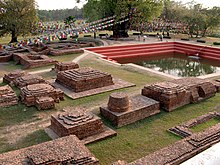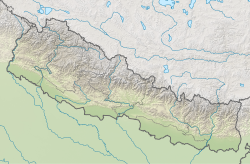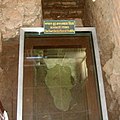Lumbini
| UNESCO World Heritage Site | |
|---|---|
 | |
| Location | Rupandehi District, Nepal |
| Criteria | Cultural: iii, vi |
| Reference | 666 |
| Inscription | 1997 (21st Session) |
| Area | 1.95 ha |
| Buffer zone | 22.78 ha |
| Coordinates | 27°28′53″N 83°16′33″E / 27.48139°N 83.27583°E |
Lumbini
लुम्बिनी | |
|---|---|
City | |
| Country | Nepal |
| Elevation | 150 m (490 ft) |
| Time zone | UTC+05:45 (NST) |
| Postal Code | 32914 |
| Area code | 71 |
Lumbinī (Nepali and Sanskrit: लुम्बिनी , "the lovely") is a Buddhist pilgrimage site in the Rupandehi District of Province No. 5 in Nepal. It is the place where, according to Buddhist tradition, Queen Mayadevi gave birth to Siddhartha Gautama in 563 BCE.[1][2] Gautama, who achieved Enlightenment some time around 528 BCE,[3][4] became the Buddha and founded Buddhism.[5][6][7] Lumbini is one of many magnets for pilgrimage that sprang up in places pivotal to the life of the Buddha.


Lumbini has a number of temples, including the Mayadevi Temple and several others which are still under repair. Many monuments, monasteries and a museum, the Lumbini International Research Institute, are also within the holy site. Also there is the Puskarini, or Holy Pond, where the Buddha's mother took the ritual dip prior to his birth and where he had his first bath. At other sites near Lumbini, earlier Buddhas were, according to tradition, born, then achieved ultimate Enlightenment and finally relinquished their earthly forms.
Lumbini was made a World Heritage Site status by UNESCO in 1997.[1][2]
In Buddha's time
In the Buddha's time, Lumbini was situated in east of Kapilavastu and southwest Devadaha of Shakya kingdom.[8][9] According to Buddhist tradition, it was there, that the Buddha was born.[10] A pillar discovered at Rummindei in 1896 is believed to mark the spot of Ashoka's visit to Lumbini. The site was not known as Lumbini before the pillar was discovered.[11] According to an inscription on the pillar, it was placed there by the people then in charge of the park to commemorate Ashoka visit and gifts.[12] The park was previously known as Rummindei, 2 mi (2 mi (3.2 km)) north of Bhagavanpura.
The Sutta Nipáta (vs. 683) states that the Buddha was born in a village of the Sákyans in the Lumbineyya Janapada. The Buddha stayed in Lumbinívana during his visit to Devadaha and there preached the Devadaha Sutta.[13]
Rediscovery
| Pilgrimage to |
| Buddha's Holy Sites |
|---|
 |
In 1896, General Khadga Samsher Rana and Alois Anton Führer discovered a great stone pillar at Rummindei, according to the crucial historical records made by the ancient Chinese monk-pilgrim Xuanzang in the 7th century CE and by another ancient Chinese monk-pilgrim Faxian in the early 5th century CE. The Brahmi inscription on the pillar gives evidence that Ashoka, emperor of the Maurya Empire, visited the place in 3rd-century BCE and identified it as the birth-place of the Buddha. The inscription was translated by Paranavitana:[14][note 1]
When King Devandmpriya Priyadarjsin had been anointed twenty years, he came himself and worshipped (this spot). He caused it to be announced that the Buddha Shakyamuni was born here and thereby caused to be created a strong desire (among people) for (that spot). He also caused a stone pillar to be set up (so as to indicate) that the Blessed One was born here. He made the village of Lummini free of taxes and made it a partaker of prosperity.
Excavation at the Mayadevi Temple in 2013
According to Robin Coningham, excavations beneath existing brick structures at the Mayadevi Temple at Lumbini provide evidence for an older timber structure beneath the walls of a brick Buddhist shrine built during the Ashokan era (3rd-century BCE). The layout of the Ashokan shrine closely follows that of the earlier timber structure, which suggests a continuity of worship at the site. The pre-Mauryan timber structure appears to be an ancient tree shrine. Radiocarbon dating of charcoal from the wooden postholes and optically stimulated luminescence dating of elements in the soil suggests human activity began at Lumbini around 1000 BCE.[17] The site, states Coningham, may be a Buddhist monument from 6th-century BCE. Other scholars state that the excavations revealed nothing that is Buddhist, and they only confirm that the site predates the Buddha.[18][19]
Present-day
Lumbini is 4.8 km (3 mi) in length and 1.6 km (1.0 mi) in width. The holy site of Lumbini is bordered by a large monastic zone in which only monasteries can be built, no shops, hotels or restaurants. It is separated into an eastern and western monastic zone, the eastern having the Theravadin monasteries, the western having Mahayana and Vajrayana monasteries.
The holy site of Lumbini has ruins of ancient monasteries, a sacred Bodhi tree, an ancient bathing pond, the Ashokan pillar and the Mayadevi Temple, where the supposed place of birth of Buddha is located. From early morning to early evening, pilgrims from various countries perform chanting and meditation at the site.
A non-governmental organization named Samriddhi Foundation started in 2013 working extensively in the field of education and health specially in government schools of the area where underprivileged children study. A non-governmental organisation called "Asia Pacific Exchange and Cooperation Foundation" (APECF) backed by chairman of the Unified Communist Party of Nepal (Maoist) and then Prime Minister Prachanda, the Chinese government and a UN group called "United Nations Industrial Development Organization" (UNIDO) signed a deal to develop Lumbini into a "special development zone" with funds worth $3 billion.[20] The venture was a China-UN joint project. A broader 'Lumbini Development National Director Committee' under the leadership of Pushpa Kamal Dahal was formed on 17 October 2011.[21] The six-member committee included Communist Party of Nepal (Unified Marxist-Leninist) leader Mangal Siddhi Manandhar, Nepali Congress leader Minendra Rijal, Forest Minister Mohammad Wakil Musalman, among other leaders. The committee was given the authority to "draft a master plan to develop Lumbini as a peaceful and tourism area and table the proposal" and the responsibility to gather international support for the same.[21]

Nipponzan Myohoji decided to build a Peace Pagoda in the park in 2001, which is visited by many different cultures and religions every day.
Because some Hindus regard the Buddha as an incarnation of Vishnu, thousands of Hindus have begun to come here on pilgrimage during the full moon of the Nepali month of Baisakh (April–May) to worship Queen Mayadevi as Rupa Devi, the mother goddess of Lumbini.
Lumbini was granted World Heritage status by UNESCO in 1997.[1][2]
On the Nepali rupee
Nepal's central bank has introduced a 100-rupee Nepali note featuring Lumbini, the birthplace of Buddha. The Nepal Rastra Bank said the new note would be accessible only during the Dashain, Nepal's major festival in October 2013. It displays the portrait of Mayadevi, Gautam Buddha's mother in silver metallic on the front. The note also has a black dot which would help the blind recognise the note. The name of the central bank in Latin script would be printed on the note along with the date of printing in both the Christian Era and the Bikram Era. The new note is being issued following a cabinet decision 27 August.[22]
Transport
Lumbini is a 5-hour drive from Kathmandu and a 30-minute drive from Bhairahawa. The closest airport is Gautam Buddha Airport at Bhairahawa, with flights to and from Kathmandu.[23]
The India border town Sonauli is 1 hour drive from Lumbini and Gorakhpur railway station in India is 4 hours drive from Lumbini.
Foreign visitors (2012–2014)
| Year | Jan | Feb | Mar | Apr | May | Jun | Jul | Aug | Sept | Oct | Nov | Dec | Total |
|---|---|---|---|---|---|---|---|---|---|---|---|---|---|
| 2014 | 8,356 | 17,964 | 20,037 | 6,843 | 2,553 | 2,111 | 2,726 | 14,123 | 7,999 | 16,433 | 21,089 | 12,765 | 132,926[24] |
| 2013 | 9,371 | 17,869 | 22,581 | 7,101 | 3,654 | 3,552 | 3,621 | 9,685 | 7,351 | 13,610 | 16,483 | 10,618 | 125,496[25] |
| 2012 | 6,591 | 20,045 | 20,519 | 8,295 | 1,316 | 1,366 | 2,651 | 17,924 | 7,955 | 13,099 | 21,740 | 14,566 | 136,067[25] |
Gallery
-
Maya Devi Temple
-
Great Drigung Kagyud lotus Stupa
-
Bodhi tree and pond at Lumbini
-
Marker stone, purportedly the exact birthplace of Gautama Buddha
-
The ancient Mayadevi Temple, Lumbini, Nepal.
-
Pillar Edict of Ashoka
-
Eternal Peace Flame
-
Burmese Lokamani Cula Pagoda
-
Chinese Maitreya Temple
-
Buddhist monks
-
Shanti stupa lumbini
See also
Notes
References
- ^ a b c UNESCO World Heritage Centre - World Heritage Committee Inscribes 46 New Sites on World Heritage List
- ^ a b c "Lumbini, the Birthplace of the Lord Buddha". UNESCO. Retrieved 1 March 2011.
- ^ Cousins, LS (1996). "The Dating of the Historical Buddha: A Review Article". Journal of the Royal Asiatic Society. 6 (1): 57–63. doi:10.1017/s1356186300014760. JSTOR 25183119. Archived from the original on 24 December 2010.
{{cite journal}}: Unknown parameter|deadurl=ignored (|url-status=suggested) (help) - ^ Schumann, Hans Wolfgang (2003). The Historical Buddha: The Times, Life, and Teachings of the Founder of Buddhism. Motilal Banarsidass Press. pp. 10–13. ISBN 8120818172.
- ^ "Lumbini, the Birthplace of the Lord Buddha – UNESCO World Heritage Centre". Whc.unesco.org. Retrieved 19 August 2013.
- ^ ""Gautama Buddha (B.C. 623-543)" by T.W. Rhys-Davids, The World's Great Events, B.C. 4004-A.D. 70 (1908) by Esther Singleton, pp. 124–35". Unz.org. 28 November 2012. Retrieved 19 August 2013.
- ^ "The Buddha (BC 623-BC 543) – Religion and spirituality Article – Buddha, Bc, 623". Booksie. 8 July 2012. Retrieved 19 August 2013.
- ^ "Ramagrama-Devadaha | Lumbini Development Trust". lumbini.planetwebnepal.com. Lumbini Development Trust. 2013. Retrieved 29 September 2016.
- ^ Violatti, Cristian (12 December 2013). "Kapilavastu". Kapilavastu - Ancient History Encyclopedia. Ancient History Encyclopedia. Retrieved 29 September 2016.
- ^ J.i.52, 54; Kvu.97, 559; AA.i.10; MA.ii.924; BuA.227; Cv.li.10, etc.
- ^ Sen, Dr. A. C. (2008). Buddhist shrines in India. Kolkota: Maha Bodhi Book Agency. p. 24. ISBN 978-81-87032-78-6.
- ^ See Mukerji: Asoka, p. 27; see p. 201f for details
- ^ MA.ii.810
- ^ Paranavitana, S. (Apr. - Jun., 1962). Rummindei Pillar Inscription of Asoka, Journal of the American Oriental Society, 82 (2), 163-167
- ^ Weise, Kai; et al. (2013), The Sacred Garden of Lumbini – Perceptions of Buddha's Birthplace (PDF), Paris: UNESCO, pp. 47–48, archived from the original (PDF) on 30 August 2014
- ^ Hultzsch, E. /1925). Inscriptions of Asoka. Oxford: Clarendon Press, pp. 164-165
- ^ Coningham, RAE; Acharya, KP; Strickland, KM; Davis, CE; Manuel, MJ; Simpson, IA; Gilliland, K; Tremblay, J; Kinnaird, TC; Sanderson, DCW (2013). "The earliest Buddhist shrine: excavating the birthplace of the Buddha, Lumbini (Nepal)" (PDF). Antiquity. 87 (338): 1104–23. doi:10.1017/s0003598x00049899. Archived from the original (PDF) on 5 December 2014.
{{cite journal}}: Unknown parameter|deadurl=ignored (|url-status=suggested) (help) - ^ Richard Gombrich (2013), Pseudo-discoveries at Lumbini, Oxford Center for Buddhist Studies, Oxford University
- ^ Lars Fogelin (2 March 2015). An Archaeological History of Indian Buddhism. Oxford University Press. ISBN 978-0-19-994822-2.
- ^ "Programs/Projects >> UNIDO IP Projects >> Introduction". UNIDOitpo.org. Retrieved 15 July 2011.
- ^ a b "Lumbini Development Committee formed under Dahal's leadership". ekantipur. Retrieved 17 October 2011.
- ^ Buddha’s birthplace in Nepal’s 100-rupee note – Indistan News – National, Political and States News Archived 2 December 2013 at the Wayback Machine
- ^ "Lumbini". Welcome Nepal. Retrieved 19 August 2013.
- ^ "Archived copy" (PDF). Archived from the original (PDF) on 26 April 2016. Retrieved 29 April 2016.
{{cite web}}: Unknown parameter|deadurl=ignored (|url-status=suggested) (help)CS1 maint: archived copy as title (link) - ^ a b "Archived copy" (PDF). Archived from the original (PDF) on 11 September 2014. Retrieved 9 September 2014.
{{cite web}}: Unknown parameter|deadurl=ignored (|url-status=suggested) (help)CS1 maint: archived copy as title (link)
Bibliography
- Weise, Kai; et al. (2013), The Sacred Garden of Lumbini – Perceptions of Buddha's Birthplace (PDF), Paris: UNESCO, archived from the original (PDF) on 30 August 2014
External links
- Lumbini On Trial: The Untold Story
 Lumbini travel guide from Wikivoyage
Lumbini travel guide from Wikivoyage- Lumbini at the Open Directory Project
- Lumbini at WorldHeritageSite.org Listing
- Some photos from Birth place of Lord Buddha, Lumbini
- [1] Flight Schedules to Lumbini











